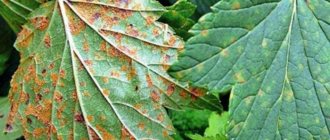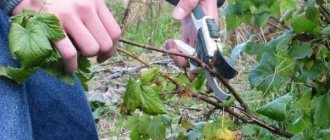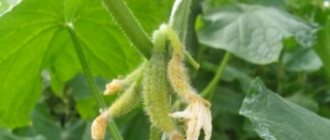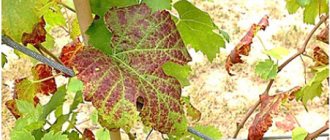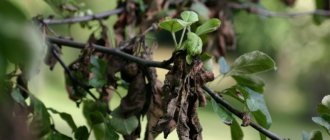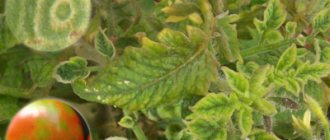Views: 1,112
Very often people do not correctly determine what is happening to their favorite currants. Making reservations for a bad year or bad weather, when they see unusual changes in the plants. Some inexperienced gardeners will not immediately understand what is wrong with their plant. However, various diseases are quite widespread in garden plots and vegetable gardens. Currants are no exception in this regard. One type of currant disease is anthracnose, which is widely and universally found in almost all garden areas of our country.
What kind of disease is this
Anthracnose is a disease caused by the marsupial fungus Pseudopeziza ribis Kleb.
Its spores affect the foliage, stems and fruits of red and black currants, depriving the plant of access to nutrients, leading to oppression and death of the bush.
What is dangerous for currants?
If you ignore the first signs of anthracnose damage to currants, the spores begin to actively spread, affecting an increasingly larger area.
Plants are losing their leaves. The red currant sheds its leaves almost immediately, while the leaves of the black currant first curl and then fall off. The spores clog the conducting vessels and prevent the bushes from fully feeding. Immunity sharply decreases, currants become vulnerable to other diseases and pests.
The harvest volume is reduced by 80-85%, the berries become smaller and lose their taste. Sometimes anthracnose recedes, but this does not mean that the disease will not return again. The spores quietly overwinter on the bush or in the soil and the next year they attack the planting again, this time completely destroying the bush.
Spreading
Infection occurs quickly under the influence of many factors.
Fungal spores are spread by:
- wind;
- rain;
- drops of water flowing down the leaves during watering;
- garden tools, if you neglect their processing;
- insects.
Currant anthracnose: tips
Currant anthracnose: photo
Specialists and experienced summer residents studied currants very carefully. And we came to the conclusion that not every bush responds well to chemical treatment. Therefore, they recommend using traditional methods first.
- At the very beginning of spring, when the buds are still dormant, the bush is treated with water. Its temperature should be slightly less than 65 degrees.
- For prevention and treatment, you can use a soap solution. To do this, rub laundry soap. And dissolve in warm water. After which the plant is sprayed with this solution.
- Bushes can be treated with a solution of onion or garlic. For 20 liters of water take 300 grams of chopped onion or garlic. The unpleasant smell of the solution will repel insects. And also prevent the occurrence of diseases.
- You can also use iodine. The solution of this substance must be weak. Because it can burn the leaves. And they will get burns. The action of iodine is very similar to the action of fungicides. For 5 liters of water, take 5-6 drops of the substance.
Note : If you planted currants in a lowland, drainage in the form of stones or bricks should usually be added to the ground before planting.
Signs of infection
Anthracnose is detected by examining the bushes. Often external signs are confused with the effects of acid rain.
The first symptoms are noted before the end of currant flowering. First, tiny light yellow-green spots with glossy bumps in the center form on the lower leaves. They gradually increase until they cover the entire surface of the leaf plate. The color of the spots becomes brighter, and a dark edging appears around them.
It is at this stage that gardeners mistake the stains for the effects of acid rain, but such burns do not have a dark border. Diseased leaves stop producing chlorophyll, causing them to wither and fall off ahead of schedule. At this time, the spores rise higher, affecting the rest of the plant.
Reference. Because of the color of the spots, anthracnose is also called copperhead.
The next stage is the formation of gray-brown wounds in the area of petioles and young shoots. This leads to the fact that the mass of the plant decreases, it “goes bald”, new branches develop more slowly and do not have time to get stronger by winter. Currants suffer already at the first frost.
With severe damage, black growths form on the stalks and berry clusters, the fruits do not receive nutrients, which is why they lose their taste and appearance, become smaller and dry out. The disease flourishes in July and August, by which time the bushes are bare.
Who is the causative agent
The causative agent of the disease is fungi from the genus Deutromycetes, of which there are several species - Colletotrichum, Kabatiella, Gloeosporium. The pathogen is found in the foliage, under the bush, in the soil, on the affected branches of the plant; the spread of the disease begins from the lower branches. Heat and moisture - a combination that occurs when average daily temperatures rise to 22 °C in May and early June, leads to the rapid development of the disease.
Anthracnose affects not only currants. The disease appears on raspberries, strawberries, melons, grapes, and other garden crops. Currants suffer from fungus most often. During hot and dry periods, the disease develops much less frequently.
Since spores can be carried by gusts of wind, insects, fall from one plant to another with raindrops, or be carried by garden tools - to avoid the problem, it is necessary to take preventive measures.
Causes of the disease
The infection appears in May or late August, early September.
The following factors can provoke diseases:
- hot weather combined with high humidity (anthracnose is not dangerous in drought);
- improper sanitary pruning of stems, leading to serious damage to the shoots.
The risk of infection increases when pests attack. Insects spread the fungus on their legs and wings.
Plants whose immunity is weakened by disease outbreaks or lack of fertilizers are most vulnerable.
Resistant varieties
Many modern varieties are resistant to fungal diseases. Planting such seedlings guarantees stable yields and reduces the time required to care for the crop. Blackcurrant varieties that are not susceptible to anthracnose infection:
- Gift of Smolyaninova;
- Black Pearl;
- Pygmy;
- Izyumnaya.
Planting material for red and white currants must be selected especially carefully: these varieties of the crop are the most difficult to tolerate the disease. Varieties that are slightly susceptible to anthracnose:
- Victoria;
- Ilyinka;
- Generous;
- Lights of the Urals;
- White squirrel;
- Primus.
Purchasing currant seedlings in garden centers and nurseries eliminates the possibility of misgrading and reduces the risk of purchasing planting material contaminated with fungal diseases.
Treatment options
To treat anthracnose, biological products, traditional methods, fungicides and simple agricultural techniques are used.
The choice of method depends on the intensity of the lesion and the time when treatment is required. The best effect is obtained by combining several methods at once.
Chemicals
Fungicides give quick results and fight anthracnose more effectively, but they should be used only according to the instructions on the package and at a certain time.
In early spring use:
- copper sulfate;
- "DNOC";
- "Nitrafen".
Before the buds appear and open, apply:
- "Cumulus";
- "Tiovit Jet".
After flowering, preparations such as Captan and Zineb are suitable. They also carry out processing after harvesting.
Important! When processing, make sure that both sides of the leaves are wet.
Biological drugs
Biological products are non-toxic and safe for plants and humans, therefore they are used in conjunction with traditional methods during the ripening period of berries.
Gardeners especially value:
- "Fitosporin";
- "Gamair".
These agents stop the development and reproduction of the fungus, preventing the emergence of the next generation.
Agrotechnical techniques
There are several secrets that will help stop the spread of fungus . In early spring, before the buds swell, the bushes and soil are doused with hot water (+65...+70°C). At the first signs of the disease, the affected leaves and shoots are cut off and burned outside the garden area so as not to infect other plants.
The bushes should not be allowed to become too thick; preventive pruning is necessary.
After each watering or precipitation, loosen the soil and remove weeds. You should not leave fallen leaves, branches and other plant debris under the bushes.
Traditional methods
At the first signs of anthracnose, when spots are visible only on the lower leaves, folk solutions and infusions are used.
How to treat a plant:
- 300 g of garlic cloves in the husk are poured into 10 liters of boiling water and left for 24-48 hours, after which the entire bush is sprayed.
- Half a piece of laundry soap is diluted in 10 liters of water and sprayed on all plantings.
- The soil, base of the bush and shoots are treated with iodine solution (1 drop per 1 liter of water).
Treatment is carried out 1-2 times a week until signs of infection completely disappear.
Preventive measures
Preventive measures will help prevent the appearance of anthracnose:
- In autumn and spring, sanitary pruning is carried out, removing dry and damaged shoots (the tools are treated with a weak solution of potassium permanganate, and the cuts are sprinkled with wood ash);
- use microfertilizers “Fertika Autumn” and “Fertika Spring”;
- water the currants at the root, avoiding the sprinkling method;
- treat buds and bushes after picking berries with Bordeaux mixture (3%), Fthalan suspension (0.5%), Kuprozan (0.4%);
- use complex fertilizers that increase the immunity of currants.
Fertilizers are selected depending on the time of use.
Below are the most popular recipes (for 10 liters of water):
- 1 tbsp. l. potassium sulfate and ammonium nitrate, 1/2 tsp. boric acid and 3 g of ferrous sulfate - in early spring before the start of the growing season.
- 200 g ash, 1 package of sodium humate, 2 tbsp. l. potassium sulfate, 1 tbsp. l. superphosphate - during the formation of ovaries.
- 1 tablet of biostimulating agent “Immunocytophyte”, 2 tbsp. l. potassium sulfate, 1 tbsp. l. superphosphate - during the flowering period, then repeat after the end of flowering and a third time - after 30 days.
Complex fertilizers help currants receive a large amount of nutrients, strengthen the immune system, increase resistance to insect attacks, allow you to quickly increase green mass and speed up the ripening of berries.
Prevention
Preventing anthracnose from appearing on currants is much easier than curing the infection. Effective methods of disease prevention:
- Pruning is a mandatory annual procedure. Remove old damaged branches, shoots, shoots that thicken the bush. Form a shrub crown with evenly lit, well-ventilated branches.
- Balanced feeding . At the beginning of the season, nitrogen-containing fertilizers are applied, and from mid-summer the currants are provided with potassium and phosphorus.
- Soil deoxidation . In the autumn, dolomite flour, slaked lime or chalk are added between the rows.
- Stimulating immunity . Currant bushes are sprayed with biostimulants - Epin-Extra, Zircon.
- Fungicide treatment . After autumn pruning, preventative spraying of currant bushes is carried out with 3% Bordeaux mixture or copper sulfate solution. The procedure allows you to disinfect the cut sites and destroy pathogenic microflora.
Autumn treatment of the currant root zone helps prevent the development of anthracnose next season. Carefully collect and destroy all biological debris - fallen leaves, cuttings of branches. The soil is sprayed with Bordeaux mixture or iron sulfate.
Anthracnose is a serious disease of currants that is easier to treat in the early stages of damage. Control measures must be applied immediately: a long course of the disease reduces the immunity of the bush and leads to loss of yield. Complex treatment of currant anthracnose using industrial preparations and folk remedies makes it possible to completely improve the health of the bush and prevent recurrence of the disease in the next season.

